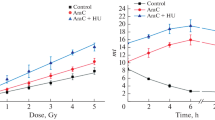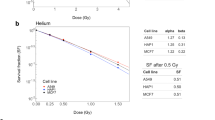Abstract
Due to their ballistic precision, apoptosis induction by protons could be a strategy to specifically eliminate neoplastic cells. To characterize the cellular and molecular effects of these hadrons, we performed dose-response and time-course experiments by exposing different cell lines (PC3, Ca301D, MCF7) to increasing doses of protons and examining them with FACS, RT-PCR, and electron spin resonance (ESR). Irradiation with a dose of 10 Gy of a 26,7 Mev proton beam altered cell structures such as membranes, caused DNA double strand breaks, and significantly increased intracellular levels of hydroxyl ions, are active oxygen species (ROS). This modified the transcriptome of irradiated cells, activated the mitochondrial (intrinsic) pathway of apoptosis, and resulted in cycle arrest at the G2/M boundary. The number of necrotic cells within the irradiated cell population did not significantly increase with respect to the controls. The effects of irradiation with 20 Gy were qualitatively as well as quantitatively similar, but exposure to 40 Gy caused massive necrosis. Similar experiments with photons demonstrated that they induce apoptosis in a significantly lower number of cells and in a temporally delayed manner. These data advance our knowledge on the cellular and molecular effects of proton irradiation and could be useful for improving current hadrontherapy protocols.
Similar content being viewed by others
References
Okada H, Mak TW. Pathways of apoptotic and non-apoptotic death in tumour cells. Nature Rev Cancer 2004; 4: 592–603.
Kerr JFR, Harman BV. Definition and incidence of apoptosis. In: Tomei LD, Cope FO, eds. Apoptosis, the Molecular Bases of Cell Death, Cold Spring Harbor Laboratory Press 1991: 5–29.
Hengartner MO. The biochemistry of apoptosis. Nature 2000; 407: 770–776.
Meier P, Finch A, Evan G. Apoptosis in development. Nature 2000; 407: 796–801.
Savill J, Fadok V. Corpse cleaning defines the meaning of cell death. Nature 2000; 407: 784–788.
Aravind L, Dixit VM, Koonin EV. Apoptotic molecular machinery: Vastly increased complexity in vertebrates revealed by genome comparisons. Science 2001; 291: 1279–1284.
Adams JM, Cory S. The Bcl-2 protein family: Arbiters of cell survival. Science 1998; 281: 1322–1326.
Korsmeyer SJ. Bcl-2 gene family and the regulation of programmed cell death. Cancer Res 1999; 59: 1693s–1700s.
Cory S, Adams JM. The Bcl-2 family: Regulators of the cellular life-or-death switch. Nature Rev Cancer 2002; 2: 647–656.
Murray AW, Marks D. Can sequencing shed light on cell cycling? Nature 2001; 409: 844–846.
Evan G, Littlewood TA. A matter of life and death. Science 1998; 281: 1317–1321.
Evan GI, Vousden KH. Proliferation, cell cycle and apoptosis in cancer. Nature 2001; 411: 342–348.
Hoeijmakers JH. Genome maintenance mechanisms for preventing cancer. Nature 2000; 411: 366–374.
Wood RD, Mitchell M, Sgouros J, Lindahl T. Human DNA repair genes. Science 2001; 291: 1284–1289.
Saraste M. Oxidative phosphorylation at the fin de siecle. Science 1999; 283: 1488–1492.
Martinou JC, Green DR. Breaking the mitochondrial barrier. Nature Rev 2001; 283: 63–67.
Zamzani N, Kroemer G. The mitochondrion in apoptosis. Nature Rev 2001; 2: 67–71.
Michaelson J. The significance of cell death. In: Tomei LD and Cope FO, eds. Apoptosis, the Molecular Bases of Cell Death. Cold Spring Harbor Laboratory Press 1991: 31–46.
Lockshin RA, Zakeri Z. Programmed cell death and apoptosis. In: Tomei LD, Cope FO, eds. Apoptosis, the Molecular Bases of Cell Death. Cold Spring Harbor Laboratory Press 1991: 47–60.
Koonin EV, Aravind L. Origin and evolution of eukaryotic apoptosis: The bacterial connection. Cell Death Diff 2002; 9: 394–404.
Proceedings of the Meeting Apoptosis: From signaling pathways to therapeutic tools. http://www.transduction-meeting.lu 2003.
Onori S, De Angelis C, Fattibene P, et al. Dosimetric characterization of silicon and diamond detectors in low energy proton beams. Phys Med Biol 2000; 45: 3045–3058.
Raffaele L, Cuttone G, Barone Tonghi L. Use of 70 MeV proton beam for medical application at INFN—LNS. Proceedings of the International Conference on Nuclear Data, ISFN, Trieste, 1997; 1668–1673.
IAEA, Technical Reports Series, IAEA, Vienna 1997: 381.
Cuttone G, Raffaele L, Barone Tonghi L. First dosimetry intercomparison results for the CATANA Project. Phys Med 1999; 15: 121–130.
Purrello M, Scalia M, Corsaro C, Di Pietro C, Piro S, Sichel G. Melanosynthesis, differentiation and apoptosis in Kupffer cells from Rana esculenta. Pigment Cell Res 2001; 14: 126–131.
Purrello M, Di Pietro C, Rapisarda A, et al. Genes for human general transcription initiation factors TFIIIB, TFIIIB-Associated Proteins, TFIIIC2, and PTF/SNAPC: Functional and positional candidates for tumour predisposition or inherited genetic diseases? Oncogene 2001; 20: 4877–4883.
Piro S, Patanè G, Di Pietro C, et al. Exposure to FFA or to high levels of glucose increases apoptosis in rat pancreatic islets cells. Metabolism 2002; 51: 1340–1347.
Tabbì G, Fry SC, Bonomo RP. ESR study of non-enzymic scission of xyloglucan by an ascorbate—H2O2- copper system: The involvement of the hydroxyl radical and the degradation of ascorbate. J Inorg Biochem 2001; 84: 179–187.
Duling DR. Simulation of multiple isotropic spin trap EPR spectra. J Magn Res 1994; 104: 105–110.
Cramer H. Mathematical Methods of Statistics. Princeton University Press, Princeton, USA 1946.
Dudewicz EJ, Mishra SN. Modern Mathematical Statistics, Wiley New York, USA 1988.
Hamid T, Kakar SS. PTTG/securin activates expression of p53 and modulates its function. Mol Cancer 2004; 3: 18.
Neu-Yilik G, Gehring NH, Hentze MW, Kulozik AE. Nonsense-mediated mRNA decay: From vacuum cleaner to Swiss army knife. Genome Biol 2004; 5: 218.
Peto J. Cancer epidemiology in the last century and the next decade. Nature 2001; 411: 390–395.
American Cancer Society. Cancer Facts and Figures http://www.cancer.org. 2002.
Lewanski CR, Gullick WJ. Radiotherapy and cellular signalling. The Lancet Oncol 2001; 2: 366–370.
Johnstone RW, Ruefli AA, Lowe SW. Apoptosis: A link between cancer genetics and chemotherapy. Cell 2002; 108: 153–164.
Rosenberg SA. Progress in human tumour immunology and immunotherapy. Nature 2000; 411: 380–384.
Appelbaum FR. Haematopoietic cell transplantation as immunotherapy. Nature 2000; 411: 385–389.
Nicholson DW. From bench to clinic with apoptosis based therapeutic agents. Nature 2000; 407: 810–816.
Tamm I, Schriever F, Dorken B. Apoptosis: Implications of basic research for clinical oncology. The Lancet Oncol. 2001; 2: 33–42.
Hug FB, Nevinny-Stickel M, Fuss M, Miller DW, Shaefer RA, Slater JD. Conformal proton radiation treatment for retroperitoneal neuroblastoma: Introduction of a novel technique. Med Ped Oncol 2001; 37: 36–41.
Noel G, Habrand JL, Helfre S, et al. Proton beam therapy in the management of central nervous system tumors in childhood: The preliminary experience of the Centre de Protontherapie d'Orsay. Med Ped Oncol 2003; 40: 309–315.
Polyak K, Xia Y, Zweier JL, Kinzler KW, Vogelstein B. A model for p53 induced apoptosis. Nature 1997; 389: 300–306.
Carr AM. Piecing together the p53 puzzle. Science 2000; 287: 1765–1766.
Flores ER, Tsai KY, Crowley D, et al. p63 and p73 are required for p53—dependent apoptosis in response to DNA damage. Nature 2000; 416: 560–564.
Vogelstein B, Lane D, Levine AJ. Surfing the p53 network. Nature 2000; 408: 307–310.
Khan AUK, Wilson T. Reactive oxygen species as cellular messengers. Curr Biol 1995; 2: 437–445.
Motoori S, Majima HJ, Ebara M, et al. Overexpression of mitochondrial Manganese Superoxide Dismutase protects against radiation induced cell death in the human hepatocellular carcinoma cell line HLE. Cancer Res 2001; 61: 5382–5388.
Epperly MW, Sikora CA, De Filippi SJ, et al. Manganese superoxide dismutase (SOD2) inhibits radiation induced apoptosis by stabilization of the mitochondrial membrane. Rad Res 2002; 157: 568–577.
Kroemer G, Zamzami N, Susin SA. Mitochondrial control of apoptosis. Immun Today 1997; 18: 44–51.
Rich T, Allen RL, Wyllie AH. Defying death after DNA damage. Nature 2000; 407: 777–781.
Li L, Story M, Legerski RJ. Cellular responses to ionizing radiation damage. Int J Rad Oncol Biol Phys 2001; 49: 1157–1162.
Belli M, Bettega D, Calzolari P, et al. Inactivation of human normal and tumour cells irradiated with low energy protons. Int J Radiat Biol 2000; 76: 831–839.
Green LM, Murray DK, Tran DT, et al. Response of thyroid follicular cells to gamma irradiation compared to proton irradiation. I. Initial characterization of DNA damage, micronucleus formation, apoptosis, cell survival, and cell cycle phase redistribution. Radiat Res 2001; 155: 32–42.
Strasser-Wozak EMC, Hartmann BL, Geley S, et al. Irradiation induces G2/M cell cycle arrest and apoptosis in p53-deficient lymphoblastic leukaemia cells without affecting Bcl-2 and Bax expression. Cell Death Diff 1998; 5: 687–693.
Ponder BA. Cancer Genet. Nature 2001; 411: 336–341.
Tate SK, Goldstein DB. Will tomorrow's medicines work for everyone? Nature Genet 2004; 36: 34–42.
Amaldi U. Future trends in cancer therapy with particle accelerators. Z Med Phys 2004; 14: 7–16.
Author information
Authors and Affiliations
Corresponding author
Rights and permissions
About this article
Cite this article
Di Pietro, C., Piro, S., Tabbì, G. et al. Cellular and molecular effects of protons: Apoptosis induction and potential implications for cancer therapy. Apoptosis 11, 57–66 (2006). https://doi.org/10.1007/s10495-005-3346-1
Published:
Issue Date:
DOI: https://doi.org/10.1007/s10495-005-3346-1




